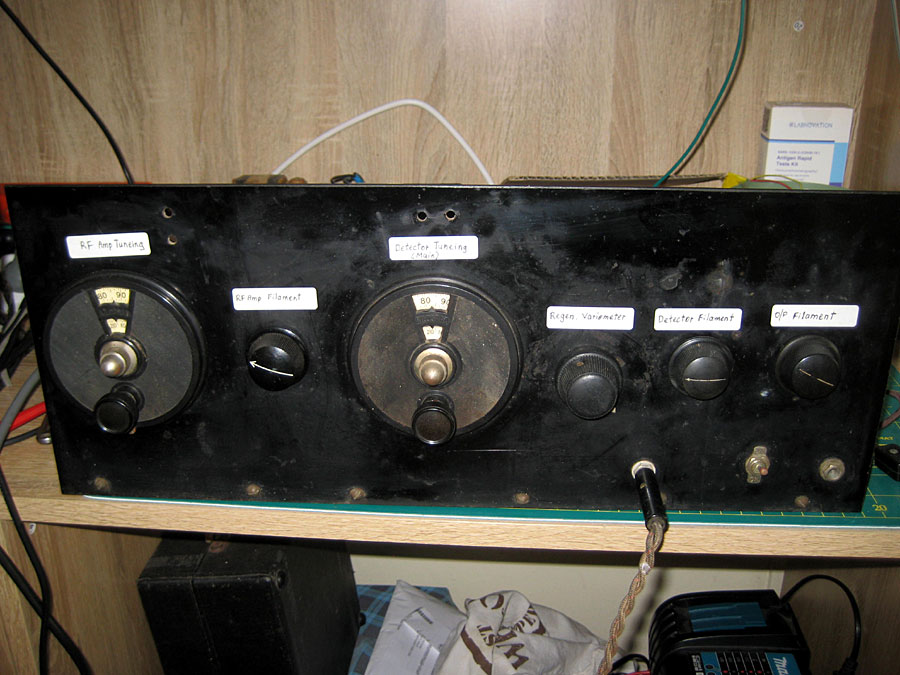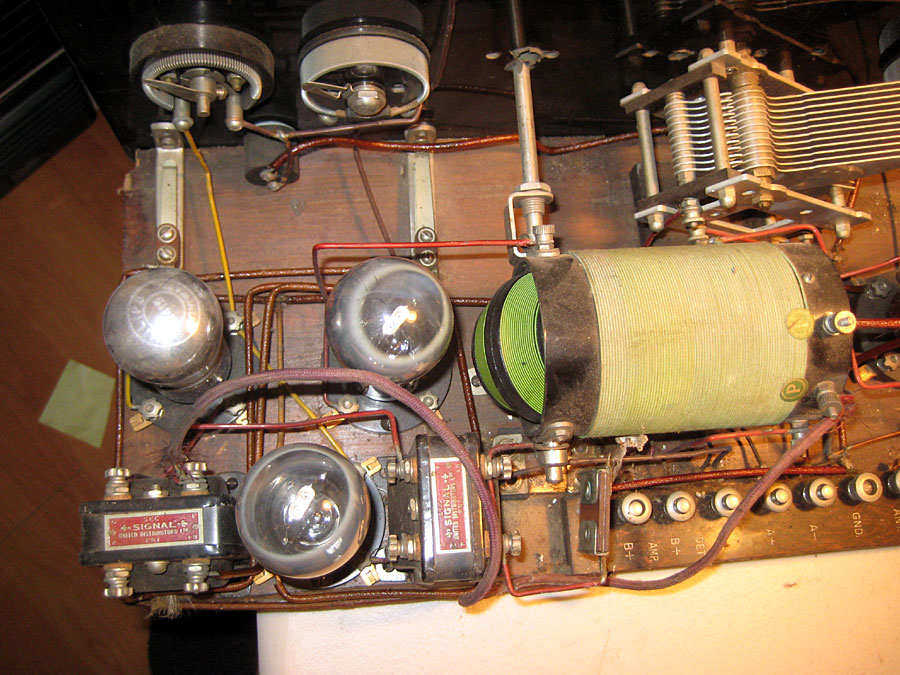Tech Talk
Forum home - Go back to Tech talk
|
Four valve neutrodyne
|
|
|
Return to top of page · Post #: 1 · Written at 3:04:43 PM on 31 May 2023.
|
|
|
|
Location: Bathurst, NSW
Member since 7 August 2008 Member #: 336 Postcount: 405 |
|
Recently I acquired a homebrew neutrodyne set. Valves A415 RF Amp, 172B Detector, 172B 1st Audio, A415 Audio o/p. At least that is the valve lineup as found.   Circuit diagram for this radio |
|
|
Return to top of page · Post #: 2 · Written at 9:39:35 PM on 31 May 2023.
|
|
|
|
Location: Wangaratta, VIC
Member since 21 February 2009 Member #: 438 Postcount: 5595 |
|
Those things look simple, but they are not. |
|
|
Return to top of page · Post #: 3 · Written at 7:35:59 AM on 1 June 2023.
|
|
|
|
Location: Bathurst, NSW
Member since 7 August 2008 Member #: 336 Postcount: 405 |
|
Have drawn a circuit and sent it off for processing. |
|
|
Return to top of page · Post #: 4 · Written at 10:03:06 AM on 1 June 2023.
|
|
|
|
Location: Wangaratta, VIC
Member since 21 February 2009 Member #: 438 Postcount: 5595 |
|
The rheostat is the volume control. A415 at 150V plate need-4.5V on the grid. If there is too much radiation and poor neutralisation & too much gain, or regeneration, that's when they oscillate. |
|
|
Return to top of page · Post #: 5 · Written at 10:32:57 AM on 1 June 2023.
|
|
|
|
Location: Bathurst, NSW
Member since 7 August 2008 Member #: 336 Postcount: 405 |
|
Yes the last rheostat is the volume control although so loud is the signal have to reduce the rheostat for the RF amp valve a bit. |
|
|
Return to top of page · Post #: 6 · Written at 11:07:59 AM on 1 June 2023.
|
|
|
|
Location: Hill Top, NSW
Member since 18 September 2015 Member #: 1801 Postcount: 2193 |
|
Sounds like you've picked up a good radio. |
|
|
Return to top of page · Post #: 7 · Written at 5:10:34 PM on 1 June 2023.
|
|
|
|
Location: Bathurst, NSW
Member since 7 August 2008 Member #: 336 Postcount: 405 |
|
Alas have had to put the project aside as soon to be away for a couple of weeks. Upon my return will finish tyding up things such as the grid bias and a couple of other matters. |
|
|
Return to top of page · Post #: 8 · Written at 8:13:00 PM on 5 June 2023.
|
|
|
|
Administrator
Location: Naremburn, NSW
Member since 15 November 2005 Member #: 1 Postcount: 7548 |
|
Photos and document uploaded. ‾‾‾‾‾‾‾‾‾‾‾‾‾‾‾‾‾‾‾‾‾‾‾‾‾‾‾‾‾‾‾‾‾‾‾‾‾‾‾‾‾‾‾‾‾‾‾‾‾‾‾‾‾‾‾‾‾‾‾‾‾‾‾‾‾‾‾‾ A valve a day keeps the transistor away... |
|
|
Return to top of page · Post #: 9 · Written at 8:29:43 PM on 5 June 2023.
|
|
|
|
Location: Wangaratta, VIC
Member since 21 February 2009 Member #: 438 Postcount: 5595 |
|
One of the first wires to clean up is that cloth one. In the ideal world, wires should cross at 90 degrees. |
|
|
Return to top of page · Post #: 10 · Written at 7:17:44 AM on 8 June 2023.
|
|
|
|
Location: Bathurst, NSW
Member since 7 August 2008 Member #: 336 Postcount: 405 |
|
Thanks Brad for putting the photos in. Did the circuit diagram one get through ? |
|
|
Return to top of page · Post #: 11 · Written at 9:07:34 AM on 8 June 2023.
|
|
|
|
Location: Hill Top, NSW
Member since 18 September 2015 Member #: 1801 Postcount: 2193 |
|
Did the circuit diagram one get through ? |
|
|
Return to top of page · Post #: 12 · Written at 10:55:08 AM on 8 June 2023.
|
|
|
|
Location: Wangaratta, VIC
Member since 21 February 2009 Member #: 438 Postcount: 5595 |
|
A commercial battery holder can be adapted for bias. Beware: If using a 7905 or similar for bias; Grids draw infinitely small current. So a loading resistor for 5mA will be needed, or it won't regulate. |
|
|
Return to top of page · Post #: 13 · Written at 3:12:26 PM on 6 July 2023.
|
|
|
|
Location: Bathurst, NSW
Member since 7 August 2008 Member #: 336 Postcount: 405 |
|
After having been away for a few weeks recommenced work on this set. After a lot of experimentation found a bias of -ve 3 volts for the grids of the two audio valves is best. |
|
|
Return to top of page · Post #: 14 · Written at 10:21:55 AM on 8 July 2023.
|
|
|
|
Location: Wangaratta, VIC
Member since 21 February 2009 Member #: 438 Postcount: 5595 |
|
With battery sets like that I have a still to be electrically overhauled Philips 3003 unit from the 1920's. Its on Radio Museum. |
|
|
Return to top of page · Post #: 15 · Written at 1:28:29 PM on 9 July 2023.
|
|
|
|
Location: Bathurst, NSW
Member since 7 August 2008 Member #: 336 Postcount: 405 |
|
Have made up a H.T battery bank with AAA cells, plenty of capacity. This battery bank is used with other radios as well. |
|
|
You need to be a member to post comments on this forum.
|
|

Sign In

Vintage Radio and Television is proudly brought to you by an era where things were built with pride and made to last.
DISCLAIMER: Valve radios and televisions contain voltages that can deliver lethal shocks. You should not attempt to work on a valve radio or other electrical appliances unless you know exactly what you are doing and have gained some experience with electronics and working around high voltages. The owner, administrators and staff of Vintage Radio & Television will accept no liability for any damage, injury or loss of life that comes as a result of your use or mis-use of information on this website. Please read our Safety Warning before using this website.
WARNING: Under no circumstances should you ever apply power to a vintage radio, television or other electrical appliance you have acquired without first having it checked and serviced by an experienced person. Also, at no time should any appliance be connected to an electricity supply if the power cord is damaged. If in doubt, do not apply power.
Shintara - Keepin' It Real · VileSilencer - Maintain The Rage
